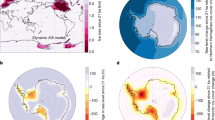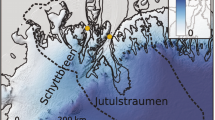Abstract
Accurate prediction of global sea-level rise requires that we understand the cause of recent, widespread and intensifying1,2 glacier acceleration along Antarctic ice-sheet coastal margins3. Atmospheric and oceanic forcing have the potential to reduce the thickness and extent of floating ice shelves, potentially limiting their ability to buttress the flow of grounded tributary glaciers4. Indeed, recent ice-shelf collapse led to retreat and acceleration of several glaciers on the Antarctic Peninsula5. But the extent and magnitude of ice-shelf thickness change, the underlying causes of such change, and its link to glacier flow rate are so poorly understood that its future impact on the ice sheets cannot yet be predicted3. Here we use satellite laser altimetry and modelling of the surface firn layer to reveal the circum-Antarctic pattern of ice-shelf thinning through increased basal melt. We deduce that this increased melt is the primary control of Antarctic ice-sheet loss, through a reduction in buttressing of the adjacent ice sheet leading to accelerated glacier flow2. The highest thinning rates occur where warm water at depth can access thick ice shelves via submarine troughs crossing the continental shelf. Wind forcing could explain the dominant patterns of both basal melting and the surface melting and collapse of Antarctic ice shelves, through ocean upwelling in the Amundsen6 and Bellingshausen7 seas, and atmospheric warming on the Antarctic Peninsula8. This implies that climate forcing through changing winds influences Antarctic ice-sheet mass balance, and hence global sea level, on annual to decadal timescales.
This is a preview of subscription content, access via your institution
Access options
Subscribe to this journal
Receive 51 print issues and online access
$199.00 per year
only $3.90 per issue
Buy this article
- Purchase on Springer Link
- Instant access to full article PDF
Prices may be subject to local taxes which are calculated during checkout




Similar content being viewed by others
References
Pritchard, H. D., Arthern, R. J., Vaughan, D. G. & Edwards, L. A. Extensive dynamic thinning on the margins of the Greenland and Antarctic ice sheets. Nature 461, 971–975 (2009)
Rignot, E. B. et al. Antarctic ice mass loss from radar interferometry and regional climate modelling. Nature Geosci. 1, 106–110 (2008)
Solomon, S. et al. Contribution of Working Group I to the Fourth Assessment Report of the Intergovernmental Panel on Climate Change 2007 (Cambridge University Press, 2007)
Dupont, T. K. & Alley, R. B. Assessment of the importance of ice-shelf buttressing to ice-sheet flow. Geophys. Res. Lett. 32, (2005)
Rott, H., Rack, W., Skvarca, P. & de Angelis, H. Northern Larsen Ice Shelf, Antarctica: further retreat after collapse. Ann. Glaciol. 34, 277–282 (2002)
Thoma, M., Jenkins, A., Holland, D. & Jacobs, S. Modelling Circumpolar Deep Water intrusions on the Amundsen Sea continental shelf, Antarctica. Geophys. Res. Lett. 35, L18602 (2008)
Holland, P. R., Jenkins, A. & Holland, D. M. Ice and ocean processes in the Bellingshausen Sea, Antarctica. J. Geophys. Res. 115, C05020 (2010)
Marshall, G. J., Orr, A., van Lipzig, N. P. M. & King, J. C. The impact of a changing Southern Hemisphere Annular Mode on Antarctic Peninsula summer temperatures. J. Clim. 19, 5388–5404 (2006)
Schoof, C. Ice sheet grounding line dynamics: steady states, stability and hysteresis. J. Geophys. Res. 112, F03S28 (2007)
Jacobs, S. S., Jenkins, A., Giulivi, C. F. & Dutrieux, P. Stronger ocean circulation and increased melting under Pine Island Glacier ice shelf. Nature Geosci. 4, 519–523 (2011)
Rignot, E. & Jacobs, S. S. Rapid bottom melting widespread near Antarctic Ice Sheet grounding lines. Science 296, 2020–2023 (2002)
Joughin, I., Smith, B. E. & Holland, D. M. Sensitivity of 21st century sea level to ocean-induced thinning of Pine Island Glacier, Antarctica. Geophys. Res. Lett. 37, L20502 (2010)
Shepherd, A. W., Wallis, D., Giles, D., Laxon, K. & Sundal, S. A. V. Recent loss of floating ice and the consequent sea level contribution. Geophys. Res. Lett. 37, L13503 (2010)
Shuman, C. A. et al. ICESat Antarctic elevation data: preliminary precision and accuracy assessment. Geophys. Res. Lett. 33, L07501 (2006)
Holland, P. R. et al. The air content of Larsen Ice Shelf. Geophys. Res. Lett. 38, L10503 (2011)
Tedesco, M. Assessment and development of snowmelt retrieval algorithms over Antarctica from K-band spaceborne brightness temperature (1979–2008). Remote Sens. Environ. 113, 979–997 (2009)
Gagliardini, O., Durand, G., Zwinger, T., Hindmarsh, R. C. A. & Le Meur, E. Coupling of ice-shelf melting and buttressing is a key process in ice-sheets dynamics. Geophys. Res. Lett. 37, L14501 (2010)
Murray, T. et al. Ocean regulation hypothesis for glacier dynamics in southeast Greenland and implications for ice sheet mass changes. J. Geophys. Res. 115, F03026 (2010)
Wåhlin, A. K., Yuan, X., Bjork, G. & Nohr, C. Inflow of Warm Circumpolar Deep Water in the Central Amundsen Shelf. J. Phys. Oceanogr. 40, 1427–1434 (2010)
Jenkins, A. & Jacobs, S. Circulation and melting beneath George VI Ice Shelf, Antarctica. J. Geophys. Res. 113, C04013 (2008)
Martinson, D. G., Stammerjohn, S. E., Iannuzzi, R. A., Smith, R. C. & Vernet, M. Western Antarctic Peninsula physical oceanography and spatio-temporal variability. Deep Sea Res. II 55, 1964–1987 (2008)
Young, I. R., Zieger, S. & Babanin, A. V. Global trends in wind speed and wave height. Science 332, 451–455 (2011)
Gille, S. T. Decadal-scale temperature trends in the Southern Hemisphere Ocean. J. Clim. 21, 4749–4765 (2008)
Hogg, A. M. C., Meredith, M. P., Blundell, J. R. & Wilson, C. Eddy heat flux in the Southern Ocean: response to variable wind forcing. J. Clim. 21, 608–620 (2008)
Schneider, D., Deser, C. & Okumura, Y. An assessment and interpretation of the observed warming of West Antarctica in the austral spring. Clim. Dyn. 38 (1–2). 323–347 (2011)
Meredith, M. P. et al. Changes in the freshwater composition of the upper ocean west of the Antarctic Peninsula during the first decade of the 21st century. Prog. Oceanogr. 87, 127–143 (2010)
Steig, E. J. Ding, Q. Battisti, D. S. & Jenkins, A. Tropical forcing of Circumpolar Deep Water Inflow and outlet glacier thinning in the Amundsen Sea Embayment, West Antarctica. Ann. Glaciol. 53, 19–28 (2012)
Fyfe, J. C. & Saenko, O. A. Human-induced change in the Antarctic Circumpolar Current. J. Clim. 18, 3068–3073 (2005)
Pritchard, H. D. et al. Corrected ICESat altimetry data, surface mass balance, and firn elevation change on Antarctic ice shelves. http://dx.doi.org/10.1594/PANGAEA.775984 (PANGAEA Data Publisher for Earth & Environmental Science, 2012)
Timmermann, R. et al. A consistent dataset of Antarctic ice sheet topography, cavity geometry, and global bathymetry. Earth Syst. Sci. Data Discuss. 3, 231–257 (2010)
Bindschadler, R. C. et al. Getting around Antarctica: new high-resolution mappings of the grounded and freely-floating boundaries of the Antarctic ice sheet created for the International Polar Year. The Cryosphere 5, 569–588 (2011)
Acknowledgements
This work was supported by funding from the ice2sea programme from the European Union 7th Framework Programme, grant number 226375. This is ice2sea contribution number 056. We thank NASA’s ICESat Science Project for distribution of the ICESat data (see http://icesat.gsfc.nasa.gov and http://nsidc.org/data/icesat). We also thank T. Urban for providing ICESat bias corrections and R. Arthern for assistance with error assessment. This paper is ESR contribution 146.
Author information
Authors and Affiliations
Contributions
H.D.P. designed and led the research. H.D.P., H.A.F. and L.P. analysed the altimetry data. S.R.M.L. and M.R.v.d.B. modelled the firn signals. All authors wrote and discussed the paper.
Corresponding author
Ethics declarations
Competing interests
The authors declare no competing financial interests.
Supplementary information
Supplementary Information
This file contains Supplementary Discussion on ice-shelf retreat or acceleration as a potential cause of ice-shelf thinning, Supplementary Methods, Supplementary Figures 1-15, legend for Supplementary Table 1, Supplementary Table 2 listing the ICESat campaigns and their biases and Supplementary References. (PDF 2511 kb)
Supplementary Table 1
This file contains Supplementary Table 1 which lists all of the ice shelves studied and their locations, their height change rate and its sample size and uncertainty, the modelled firn signal and its uncertainty, the calculated basal melt imbalance, the rate of lowering of adjacent fast and slow-flowing grounded ice (for selected ice shelves), and a comparison (where possible), to previous studies (see Supplementary Information for full legend). (XLS 53 kb)
Rights and permissions
About this article
Cite this article
Pritchard, H., Ligtenberg, S., Fricker, H. et al. Antarctic ice-sheet loss driven by basal melting of ice shelves. Nature 484, 502–505 (2012). https://doi.org/10.1038/nature10968
Received:
Accepted:
Published:
Issue Date:
DOI: https://doi.org/10.1038/nature10968
This article is cited by
-
Monitoring Earth’s climate variables with satellite laser altimetry
Nature Reviews Earth & Environment (2024)
-
Persistent warm-eddy transport to Antarctic ice shelves driven by enhanced summer westerlies
Nature Communications (2024)
-
Recent irreversible retreat phase of Pine Island Glacier
Nature Climate Change (2024)
-
The morphological changes of basal channels based on multi-source remote sensing data at the Pine Island Ice Shelf
Acta Oceanologica Sinica (2024)
-
An Amundsen Sea source of decadal temperature changes on the Antarctic continental shelf
Ocean Dynamics (2024)
Comments
By submitting a comment you agree to abide by our Terms and Community Guidelines. If you find something abusive or that does not comply with our terms or guidelines please flag it as inappropriate.



